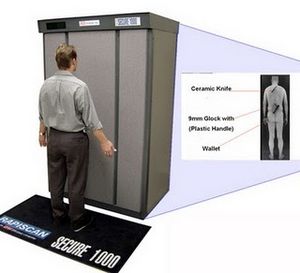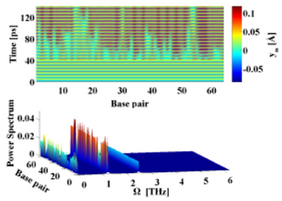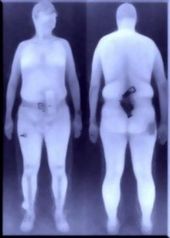Tue, 29 Dec 2009 09:36 EST
"If it's something that's going to improve safety, then I don't have any problem with it, I have nothing to hide."If you were against transhumanism before, perhaps you should give it another look. Our bodies are the product of a billion years of nature's evolutionary processes, but the War on Terror is about to irrevocably corrupt our gene pool, causing untold immune system and other genetic damage to future generations, and possibly rendering the DNA coding that we are based on unacceptably toxic.
- Ashley Houston, 32, as she waited for a plane in Phoenix (Reuters).
We may need to port our intelligence to a machine, or to cyberspace, if "human" intelligence is to survive in today's toxic environment.
While Homeland Security has installed Backscatter Advanced Imaging Technology (AIT) into airports while successfully avoiding an environmental impact statement, and the Justice Department is now fighting FOIA requests for technical specifications (filed by EPIC, Electronic Privacy Information Center), we already know that backscatter radiation may interfere directly with DNA. Although the ionizing radiation is small, the terahertz waves the machines generate do more than show your private parts to the screener. They have been found to "unzip double-stranded DNA, creating bubbles in the double strand that could significantly interfere with processes such as gene expression and DNA replication."
Radiation waves occur naturally in the environment, and we're hit with them all the time. But should we bombard ourselves with them unwillingly every time we want to board a flight? Initially the machines were supposed to be voluntary. Suddenly they are not.
The TSA issued a blog saying:
"Backscatter X-ray technology uses X-rays that penetrate clothing, but not skin, to create an image. Millimeter wave technology uses sensors to collect millimeter wave energy to measure the difference in radiated energy relative to each object against a common background (the human body produces these signatures in typical screening applications) to construct a composite image.We don't know about you, but whenever we hear a government agency use these kinds of comparisons we check our wallet.
"For comparison purposes, the X-ray dose received from the backscatter system is equivalent to the radiation received in two minutes of airplane flight at altitude (.04 millirem by backscatter [2 scans] compared to .0552 millirem for two minutes of flight).
"The [non-ionizing radio frequency] energy projected by the system is 10,000 times less than a cell phone transmission (.00000597 mW/cm2 for millimeter wave technology compared to 37.5 mW/cm2 for a cellphone)."
Backscatter X-rays are nothing like the cosmic radiation we get at high altitudes, flights included. Nor is background radiation - or cellphone radiation - safe, thank you very much.
Medical science already knows how much terahertz radiation is safe for the body to absorb: none. You can think of it like sunlight - a little may be fine while a lot, you frequent flyers, may be deadly. However, where ionizing radiation is concerned, there is something called the superlinear dose response that wrecks that sunlight analogy. Middling range exposures are fine because they destroy the cells they hit. Low range exposures are far deadlier, because DNA is mutated but the cells survive to divide.
Our genome is smaller than that of an ear of corn, with about the same number of genes as an earthworm. DNA's secrets are not just in the genes, but in the way the code is arranged. In the human cell, certain chemical bonds are crucial to the integrity of the genetic code and breaking just a few of these bonds may endow the code with a permanent alteration. When a mutated gene is responsible for regulating normal cell growth, an uncontrolled proliferation of damaged cells, or cancer, can develop. When mutation occurs in the procreative cells or in the developing embryo, birth defects can result. When mutation occurs in the blood-forming tissue, impairment of the immune response system can result, and this can increase susceptibility to an entire spectrum of human disease.
Radiation is therefore said to be mutagenic (cell-mutating), carcinogenic (cancer-causing), teratogenic (birth-defect inducing), and immuno-suppressing (resistance-impairing). All of these effects, which begin at a submicroscopic level, remain invisible for extended periods of time until they reach observable proportions. The latent period may be decades in the case of an incipient cancer, or it may be centuries in the case of a genetic effect.
Even where the risk is very slight, if the population to be exposed is very large - several billion air-traveler-exposures annually - the epidemiological burden is overcome and real deaths result. Far more deaths, it may be (we won't know as long as FOIA immunity reigns) than deaths from terrorist air hijackings.
Most predictive models also make the assumption that the exposed population is homogeneous. In fact, there are subgroupings for susceptibility in the population, and equal radiation exposure can increase disease by five to ten times in the more susceptible groups over the less susceptible. All men are not created equal, and the burden of environmental radioactivity will fall more heavily on some than on others, depending on their genes. Children are very vulnerable. Fetuses even more so. As the Nuclear Regulatory Commission has acknowledged,
"Because our present state of knowledge precludes all possible meaningful quantifications of the relative radiosensitivity of a given individual, it is true that persons are not necessarily equally 'protected' by current federal regulations designed to protect the general population as a whole."One concept of the genetic mutation process put forward by the National Academy of Sciences employed a line of nucleoproteins in a normal sequence something like this: AGT-AGT-AGT-AGT-AGT-AGT-AGT.... In this model the DNA code is read and transmitted in groups of three proteins. Consider what happens if the sequence is disturbed, such as when a speeding terahertz wave dislodges one protein in the chain. The entire sequence is thrown off until two counterbalancing breaks occur that throw it back into correct order. Until then it is read: AG-TAG-TAG-TAG-TAG-TAG-TAG....
- - Jeannine Honicker v. United States of America, et al.
Suppose the AGT sequence was for brain cells, but the TAG sequence was for stomach muscles. You could get something pretty weird happening. It may have been from mutations such as these that all of us evolved. As a species, we arrived at our present form by selection of favorable mutations and elimination of unfavorable mutations, which is not to say it was a pleasant process for those individuals with the unfavorable mutations. The rate of genetic translocations in humans caused by ionizing radiation and estimated in the current the scientific literature ranges from 24 to 1,330 translocations per unit of radiation (rad) per million live births per generation. It takes on the order of 100 generations to eliminate each unfavorable mutation from the genetic pool, whether it is for a fruit fly or a baboon.
Biostatistician Rosalie Bertell has suggested that elevation of the background level of mutagens in combination with mutations which interfere with normal reproduction could result in sudden species extinction, which, if the species is humans, by the time we recognized the threat, we could be powerless to counter.
The US Supreme Court has marked this territory with a bright line. Where rights to be protected are clearly enumerated, are "so rooted in the traditions and conscience of the nation as to be ranked as fundamental," or are "implicit in the concept of ordered liberty," so that failure to protect them would mark a departure from first principles, federal authority should be conditioned upon the demonstration of an overriding interest of compelling importance, the absence of less damaging alternatives for meeting that interest, and some method of limiting or restricting the scope of the excursion and redressing the injustice created.
Over the past decade, in the United States alone, we've had sixteen million flights that got to their destinations without incident for every flight that was victimized by crime. Should we punish the millions of safe passengers to deter the one criminal? Should we sacrifice our future genetic heritage for the sake of an abstract, and likely unobtainable, perfection of our "security?"
How we define security matters. We should force ourselves to thoroughly examine alternatives in the future before embarking upon any new governmental encroachments, or putting new wrinkles on old encroachments, that carry species-ending health implications.
And Mr. Obama, tear down that secrecy wall.





